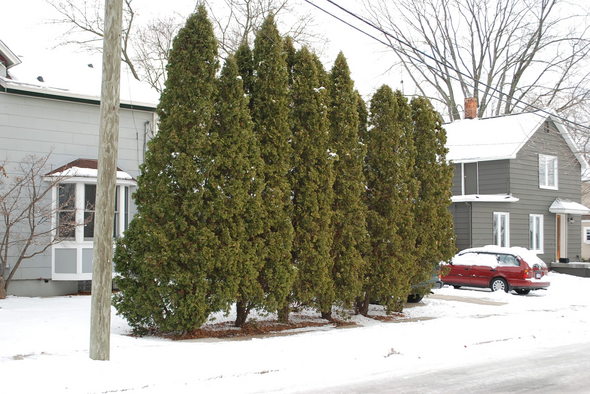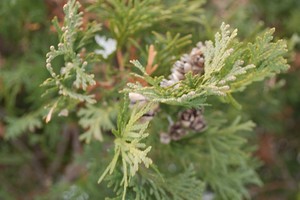Arborvitae: an evergreen for everybody

An Arborvitae/Northern Whitecedar (Thuja occidentalis) hedge braves the cold.
Rick Meader | Contributor
The straight species of arborvitae is usually found as a small tree, mostly erect in habit, but can reach a height of 50-75 feet, with a spread of 35 to 50 feet given the right conditions and time. It has very dense, green foliage that remains so throughout the year, which makes it popular in shrub form, as a stand-alone tree, or as a hedge, depending on the cultivar.'
In nature, arborvitae is often found in low, damp or mesic conditions and along lake edges, but it can also be found on open rocky hillsides that aren’t damp. According to the USDA website, it is native to the northeastern quarter of the continental United States and Canada and most Michigan counties, including Washtenaw. If you’ve ever had the pleasure of riding your bike around Mackinac Island, you’ll see it around almost the entire island. Christopher Reeve and Jane Seymour had a famous scene under some large arborvitaes in “Somewhere in Time.” A plaque memorializes the scene.
Let’s get back to the details of this beauty. Aside from its lustrous green color, a feature of its foliage that I particularly like is its softness. Each “leaf” is a flat, scale-like frond that spreads out horizontally and is very pleasant to touch. The tree’s density provides good cover for wildlife, although it isn’t a major source of food for wildlife, according to "Native Trees, Shrubs and and Vines for Urban and Rural America" (Hightshoe). It has a moderate growth rate, and can live for up to 400 years. It is very sensitive to salt, so if you do want to include it in your landscape, make sure you don’t put it where salt spray can get to it.
As it is so prevalent, you might assume that Native Americans made great use of it, and you’d be correct. They used its lumber for canoe ribs and toboggans, its bark for a variety of medicinal purposes and its leaves for pillows and numerous other uses. You can check them out at the University of Michigan-Dearborn Ethnobotany site. Even now, some people use it for homeopathic treatments.

Closeup of the soft foliage of Arborvitae
Rick Meader | Contributor
If you do want to add it to your yard, you can choose from cultivars such as ‘Hetz mdiget’ for a little 3-foot ball of a shrub, or ‘Emerald’ for a mid-sized, narrowly pyramidal tree reaching 12 feet in height, or ‘Techny’ or ‘Nigra’ for a taller, fuller tree that makes a great hedge. Of course, you can count on deer to sculpt them, as their soft foliage is a favorite forage of theirs. All in all, it’s a great, versatile species that makes a great addition to almost any yard. If you want to read some other interesting information about arborvitae, the Wikipedia entry is pretty fun reading.
It’s been awhile since I’ve written, and, as you might guess, I’ve got nada blooming in my yard, but it’s still a great time to get out and enjoy nature, especially a dense northern whitecedar swamp, so get out and find one!
Rick Meader is a local landscape architect with a special interest in all things natural, including native plants and the critters that eat them. You can contact him at yourland1824@gmail.com.


Comments
Rick Meader
Wed, Jan 5, 2011 : 11:26 p.m.
Hi everyone, Thanks for your comments, everyone. Cash is right - those wire maintenance folks are merciless when it comes to "maintaining" growth beneath their wires. Unless it's obviously a short shrub, there's a good chance they'll whack it without any sense of aesthetics, so choose short. As for why one side turns brown - it could be windburn, or perhaps some salt spray. Tim is also right. If you have a lot of deer around, don't expect your arborvitaes to stay full for the bottom 6-8' (i.e. deer browse range). The soft, green foliage is a favorite of them. Finally, Monica, I know what you mean. On the other hand, I have to believe that even the cultivars are better hosts for native insects than alien species. (See "Bringing Nature Home" by Douglas Tallamy for a full discussion of this). So, while the cultivars certainly may not truly resemble how the straight species might appear in nature, and shouldn't be used for ecological restoration projects, I still think a native cultivar is better than nothing in a planted landscape (but use the straight species if you can - you can get them from Wildtype Nursery in Macon, MI - just don't plant them beneath power lines. Rick
Monica Milla
Thu, Dec 30, 2010 : 11:58 p.m.
To me, once we create cultivars of a native plant, it's no longer a native plant. But that's just one of my rants. I'll move it along.
tim
Tue, Dec 28, 2010 : 3:58 p.m.
Another north American native ( the white tail deer ) loves to eat arborvitae. Where do northern deer like to over winter? Cedar swamps of course. What is available to eat in a cedar swamp? CEDAR--- If you have deer in your area don't plant arbs, if you don't trust me just ask someone who lives in Barton Hills.
uptodate citizen
Tue, Dec 28, 2010 : 2:56 p.m.
why does one side always turn brown and die off...?
Cash
Tue, Dec 28, 2010 : 2:21 p.m.
Great article. As a word to the wise, if you get the bug to plant one or more of the tall/giant varieties...do NOT plant them under any wires, even though they are small NOW.